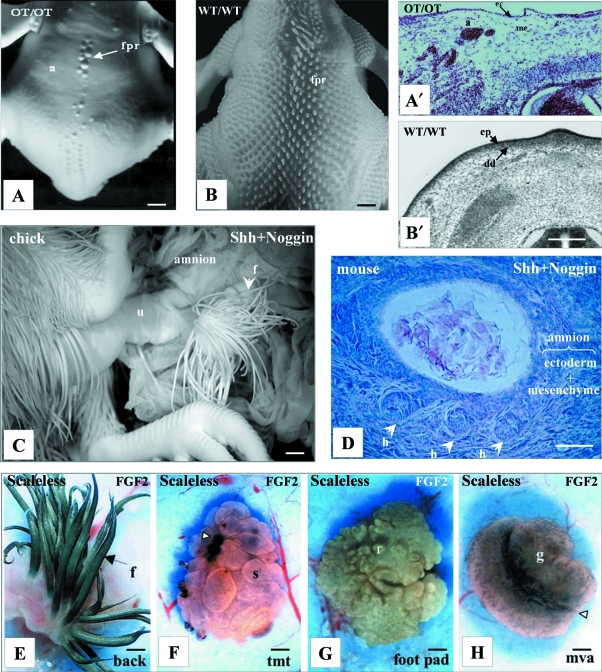Fig. 1.
The formation and regionalization of the dense dermis. (A,A′) In the chick Ottawa naked mutant (OT/OT), a dorsal view at E10 shows that most part of the skin stays glabrous (A); a transversal section at E7 shows that most parts of the mesenchyme remain loose over the neural tube (A′). Compare with the formation of feather primordia and of a dense dermis formation in a wild type embryo (WT/WT) at the same stages (B,B′). After Olivera-Martinez et al. 2004b. Reproduced with permission of Int J Dev Biol. (C) Production of an ectopic feathered skin in the chick amnion at E14, following the graft of aggregate of Shh- and Noggin-producing cells under the ectoderm at E2 in the extra-embryonic area. After Fliniaux et al. 2004a. Reproduced with permission of the Company of Biologists. (D) Production of a skin with a pluristratified epidermis and three stage 3 hair pegs by a graft under the kidney capsule of mouse amnion associated to a mixed clump of Noggin- and Shh-producing cells. After Fliniaux et al. 2004b. Reproduced with permission of Differentiation. (E–H) The chick scaleless mutant forms a skin that comprises a dense dermis and that has potential regional characteristics which can be revealed by FGF2 treatment (tmt, tarsometatarsus; mva, midventral apterium). The white arrowhead in (F) shows the FGF2 beads, and in (H) the midventral line. After Prin & Dhouailly, 2004. Reproduced with permission of Int J Dev Biol. a, apterium; dd, dense dermis; ec, ectoderm; ep, epidermis; f, feather; fpr, feather primordial; g, glabrous; h, hair bud; me, mesenchyme; r, reticula; s, scuta; u, umbilical chord. Bars: A–C: 1 mm, A′,B′: 400 µm, D: 150 µm, E–H: 200 µm.

